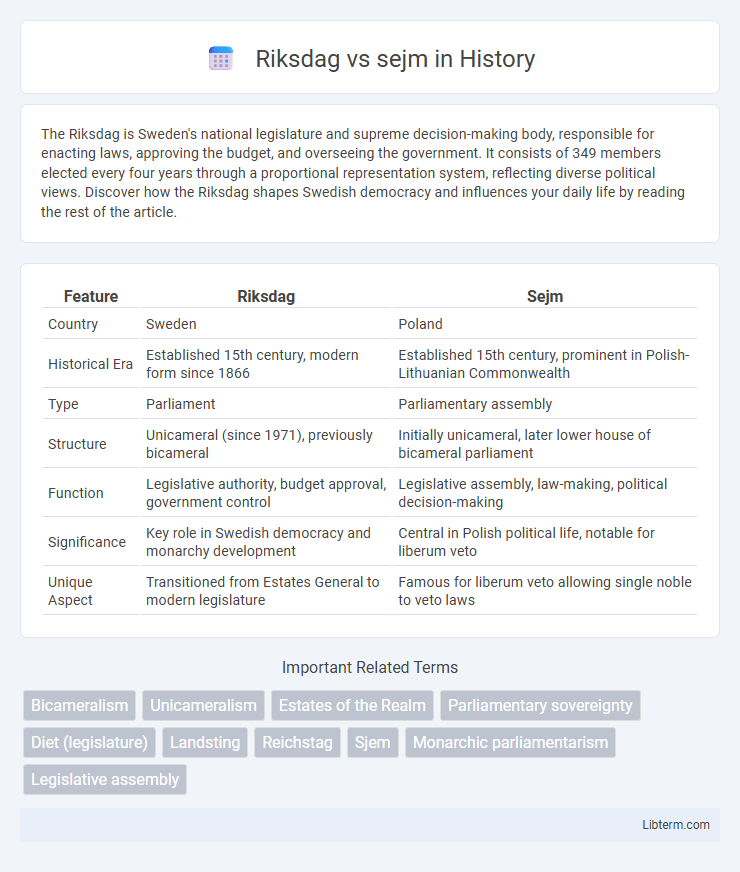The Riksdag is Sweden's national legislature and supreme decision-making body, responsible for enacting laws, approving the budget, and overseeing the government. It consists of 349 members elected every four years through a proportional representation system, reflecting diverse political views. Discover how the Riksdag shapes Swedish democracy and influences your daily life by reading the rest of the article.
Table of Comparison
| Feature | Riksdag | Sejm |
|---|---|---|
| Country | Sweden | Poland |
| Historical Era | Established 15th century, modern form since 1866 | Established 15th century, prominent in Polish-Lithuanian Commonwealth |
| Type | Parliament | Parliamentary assembly |
| Structure | Unicameral (since 1971), previously bicameral | Initially unicameral, later lower house of bicameral parliament |
| Function | Legislative authority, budget approval, government control | Legislative assembly, law-making, political decision-making |
| Significance | Key role in Swedish democracy and monarchy development | Central in Polish political life, notable for liberum veto |
| Unique Aspect | Transitioned from Estates General to modern legislature | Famous for liberum veto allowing single noble to veto laws |
Overview of Riksdag and Sejm
The Riksdag is Sweden's unicameral national legislature consisting of 349 members elected every four years, responsible for enacting laws, approving the budget, and overseeing the government. The Sejm, the lower house of Poland's bicameral parliament, comprises 460 deputies elected for four-year terms, playing a critical role in legislative processes, budget approval, and government control. Both bodies serve as the primary legislative institutions in their respective countries, reflecting distinct parliamentary systems shaped by Sweden's unitary model and Poland's semi-presidential framework.
Historical Background of Both Parliaments
The Riksdag of Sweden traces its origins to the 15th century, evolving from traditional assemblies known as "Thing" that governed local communities. The Sejm of Poland dates back to the 15th century as well, formalized during the Kingdom of Poland and the Polish-Lithuanian Commonwealth as a bicameral legislature representing the nobility. Both parliaments played pivotal roles in shaping their nations' constitutional developments and political traditions over centuries.
Structure and Composition
The Riksdag, Sweden's national legislature, is a unicameral body consisting of 349 members elected through proportional representation for four-year terms. The Sejm, the lower house of Poland's parliament, comprises 460 deputies also elected by proportional representation, serving four-year terms alongside the Senate as the upper house. Both bodies function as central legislative authorities with distinct structures reflecting their country's political frameworks.
Legislative Powers and Functions
The Riksdag, Sweden's unicameral legislature, holds comprehensive legislative powers including enacting laws, approving the budget, and overseeing the government. The Sejm, the lower house of Poland's bicameral parliament, similarly enacts legislation, controls public finances, and exercises oversight functions, particularly in initiating and amending laws. Both bodies play central roles in shaping national policy through legislative initiatives, budget approval, and government accountability mechanisms.
Election Processes and Terms
The Swedish Riksdag comprises 349 members elected every four years through a proportional representation system that ensures a balanced reflection of voter preferences nationwide. Poland's Sejm consists of 460 deputies elected every four years using an open-list proportional representation method within multi-member constituencies, allowing voters to influence candidate rankings. Both legislatures emphasize proportional representation, but the Riksdag uses a modified Sainte-Lague method, while the Sejm employs the D'Hondt method for seat allocation.
Roles of Political Parties
Political parties in the Swedish Riksdag primarily focus on coalition building and policy negotiation to influence legislation, reflecting a multiparty system with proportional representation. In contrast, Poland's Sejm operates under a mixed member proportional system where political parties play a crucial role in forming government majorities and shaping national policy through party discipline and voting blocs. Both parliaments rely heavily on party structures to organize debates, committee work, and legislative agendas, but the Sejm often experiences more pronounced party control over individual member actions.
Key Differences in Governance
The Riksdag, Sweden's unicameral legislature, operates with 349 members elected through proportional representation, emphasizing consensus-driven policymaking and a constitutional monarchy framework. In contrast, Poland's Sejm, the lower house of its bicameral parliament, consists of 460 deputies also elected by proportional representation but functions within a semi-presidential system, where the president holds significant executive power. Key governance differences include the Riksdag's role in appointing the prime minister compared to the Sejm's involvement in confidence votes and legislative control over the government's executive actions.
Interaction with Executive Branch
The Riksdag, Sweden's parliament, holds significant power over the executive branch, including the ability to approve the Prime Minister and oversee the government's actions through motions of no confidence. In contrast, the Sejm, Poland's lower house, exerts influence by ratifying the Council of Ministers' programs and has the authority to pass a vote of no confidence, thereby directly impacting the executive leadership. Both bodies serve as essential checks on their respective executives, facilitating democratic accountability and government oversight.
Public Participation and Transparency
The Riksdag of Sweden emphasizes transparent legislative processes by broadcasting sessions live and providing extensive public access to committee meetings and documents, fostering broad civic engagement. The Polish Sejm also encourages public participation through open sessions and accessible legislative information, though it faces challenges in ensuring consistent transparency due to political dynamics. Both institutions leverage digital platforms to enhance citizen involvement, with the Riksdag often cited as a model for integrating public participation in parliamentary procedures.
Contemporary Challenges and Reforms
The Riksdag faces contemporary challenges such as managing immigration policies and climate change legislation while reforming electoral laws to enhance proportional representation. The Sejm addresses issues related to judicial independence and media freedom amid reforms aimed at strengthening executive control and revising constitutional checks and balances. Both parliaments are actively adapting to shifts in political landscapes and public demands for transparency and democratic accountability.
Riksdag Infographic

 libterm.com
libterm.com